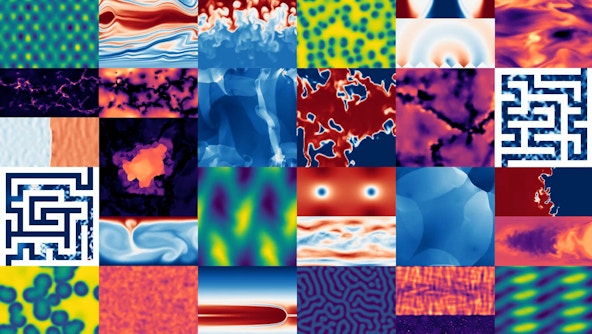The mission of the Flatiron Institute is to advance scientific research through computational methods, including data analysis, theory, modeling and simulation.
Read MoreFeatured News

Flatiron Institute researchers have identified a previously unknown way to make the universe’s heaviest atoms, such as gold, platinum and uranium. They calculate that a single flare from a supermagnetized star called a magnetar can produce the mass equivalent of 27 moons’ worth of these elements in one go.
Our Centers
Center for Computational Biology
Center for Computational Mathematics
Center for Computational Neuroscience
Center for Computational Quantum Physics
Scientific Computing Core
It develops, deploys and maintains computational infrastructure — from supercomputers to desktop PCs — dedicated solely to the use of Flatiron researchers.
Initiatives

The Simons Foundation Initiative for Computational Catalysis is a new effort within the Flatiron Institute dedicated to the development and application of computational techniques enabling the rational design of more efficient and more affordable catalysts.

Our goal is to accelerate the development of versatile foundation models tailored for numerical datasets and scientific machine learning tasks. The challenge we are undertaking is to build AI models which leverage information from heterogeneous datasets and across different scientific fields, which, contrary to domains like natural language processing, do not share a unifying representation.
Collaborative Work

Machine learning has become an indispensable tool for computational science, and it is an active and growing area of research throughout the Flatiron Institute.
- CCM
- CCN
- CCA
- CCB
- CCQ

Underlying all biological processes are molecules and their interactions with each other. However, our ability to understand how these molecules function over biologically relevant scales remains very limited.
- CCB
- CCM

This collaboration, directed by Greg Bryan of Columbia University, aims to understand and determine the evolution and initial conditions of our universe, using observations via a Bayesian forward modeling approach.
- CCA
- | Columbia University
- | Lawrence Berkeley National Lab
- | Harvard University
- | Stockholm University
- | Institute D'Astrophysique de Paris
- | Université de Montreal
- | Princeton University
- | Carnegie Mellon University
- | Max-Planck Institute for Astrophysics
Flatiron Institute Idea Scholar Program
For distinguished scientists interested in developing scientific talent in the workforce and enabling pathways to science
Scholars may engage in a variety of activities, such as working on scientific projects, starting new collaborations, mentoring junior scientists, and organizing or participating in workshops and career development events.
Software
A major effort of the Flatiron Institute is the development and support of high-quality, open-source software for research.
Research Highlights
Superfast Direct Inversion of the Nonuniform Discrete Fourier Transform via Hierarchically Semiseparable Least Squares
A direct solver is introduced for solving overdetermined linear systems involving nonuniform discrete Fourier transform matrices. Such matrices can be…
SIAM Journal on Scientific ComputingSampling From Multiscale Densities With Delayed Rejection Generalized Hamiltonian Monte Carlo
Hamiltonian Monte Carlo (HMC) is the mainstay of applied Bayesian inference for differentiable models. However, HMC still struggles to sample…
Proceedings of The 28th International Conference on Artificial Intelligence and StatisticsLevel Set Teleportation: An Optimization Perspective
We study level set teleportation, an optimization routine which tries to accelerate gradient descent (GD) by maximizing the gradient norm…
The 28th International Conference on Artificial Intelligence and StatisticNews & Announcements
May 07, 2025

April 30, 2025

April 29, 2025









